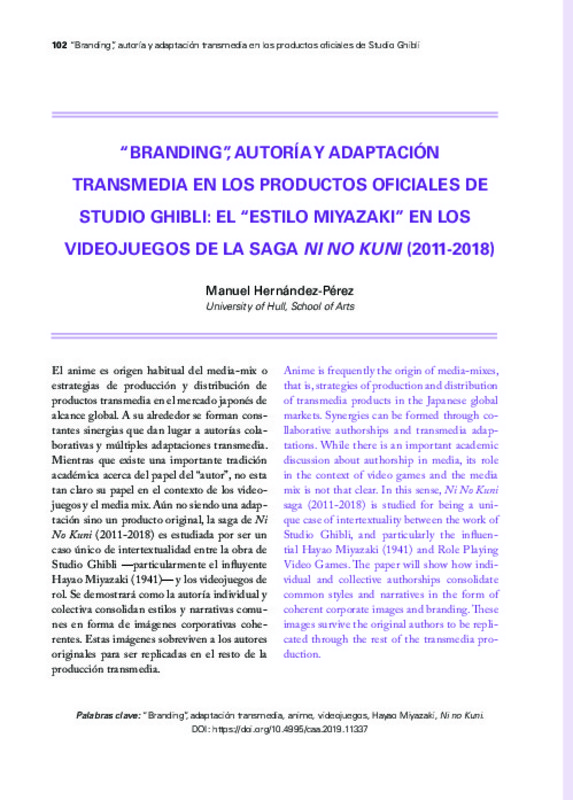BERNSTEIN, Matthew, 2008. "The producer as auteur", en GRANT, Barry Keith (ed.), Auteurs and Authorship: A Film Reader, Maldwell: Blackwell Publishing, pp. 180-89.
CARRINGER, Robert L., 2001. "Collaboration and Concepts of Authorship", en Publications of the Modern Language Association of America, Vol.116, No2, 370-379.
COOK, Dave, 2012. "Level-5: understanding Japan's best-kept secret", en VG24/7 (https://www.vg247.com/2012/12/06/level-5-understanding-japans-best-kept-secret/ [acceso: julio, 2018]).
[+]
BERNSTEIN, Matthew, 2008. "The producer as auteur", en GRANT, Barry Keith (ed.), Auteurs and Authorship: A Film Reader, Maldwell: Blackwell Publishing, pp. 180-89.
CARRINGER, Robert L., 2001. "Collaboration and Concepts of Authorship", en Publications of the Modern Language Association of America, Vol.116, No2, 370-379.
COOK, Dave, 2012. "Level-5: understanding Japan's best-kept secret", en VG24/7 (https://www.vg247.com/2012/12/06/level-5-understanding-japans-best-kept-secret/ [acceso: julio, 2018]).
DENISON, Rayna, 2010. "Anime tourism: discursive construction and reception of the Studio Ghibli Art Museum", en Japan Forum. Vol. 22, No. 3-4., pp. 545-563.
GROUPE D'ENTREVERNES, 1979. Analyse sémiotique des textes: introduction, théorie, practique, Lyon, Francia: Presses Universitaires de Lyon.
FRANK, Allegra, 2017. "Ni no Kuni 2 is aimed at Western fans, and it's better for it. A JRPG for an international crowd", en Polygon (https://www.polygon.com/2017/8/22/16183466/nino-kuni-2-impressions-gameplay-interviewgamescom-2017) [acceso: julio, 2018]).
HERNÁNDEZ-PÉREZ, Manuel, 2012. "De Perfiles y Personajes: Evolución de la Representación del usuario en las Redes Sociales y los Juegos de Rol", en Revista de Comunicación de la SEECI (Sociedad Española de Estudios de la Comunicación Iberoamericana), Año XV, 28, pp. 30-48.
HERNÁNDEZ-PÉREZ, Manuel, 2016. "Animation, branding and authorship in the construction of the 'anti-Disney' ethos: Hayao Miyazaki's works and persona through Disney film criticism" en Animation. An Interdisciplinary Journal, 11, 3, pp. 297-313.
HERNÁNDEZ-PÉREZ, Manuel, 2017. Manga, anime y videojuegos. Narrativa cross-media japonesa, Zaragoza: Prensas de la Universidad de Zaragoza.
HORNO, Antonio (2014). "El arte de la animación selectiva en las series de anime contemporáneas", en Con A de animación, nº 4, pp. 84-97. https://doi.org/10.4995/caa.2014.2164
GAN, Sheuo Hui, 2009. "To Be or Not to Be. The Controversy in Japan over the "Anime Label", en Animation Studies, n. 4, 35-43.
INCE, Steve, 2009. Writing for Video Games, Londres: Bloomsbury.
KOYAMA-RICHARD, Brigitte, 2007. One Thousand Years of Manga, Paris: Flammarion.
LEITCH, Thomas, 2007. Film Adaptation & Its Discontents. From Gone with the Wind to The Passion of the Christ, Baltimore: The Johns Hopkins University Press.
LIM, Tai Wei, 2013. "Spirited Away: Conceptualizing a Film-Based Case Study through Comparative Narratives of Japanese Ecological and Environmental Discourses", en Animation. An Interdisciplinary Journal, 8, 2, pp.149-162.
MCCARTHY, Helen, 1999. Hayao Miyazaki: master of Japanese animation: films, themes, artistry, Berkeley: Stone Bridge Press.
MIYAZAKI, Hayao, 2014. Turning Point: 1997-2008, (trad. inglés. Beth Cary and Frederik L. Schodt), San Francisco: Viz Media.
MOIST, Kevin M., BARTHOLOW, Michael, 2007. "When Pigs Fly: Anime, Auteurism, and Miyazaki's Porco Rosso" en Animation: An Interdisciplinary Journal, 2, 1, pp. 27-42.
MONTERO PLATA, Laura, 2012. El Mundo Invisible de Hayao Miyazaki, Palma de Mallorca: Dolmen.
MONTERO PLATA, Laura, 2018. "Vientos de cambio: presente y futuro de Studio Ghibli" en Con A de animación, nº 8, pp. 30-37. https://doi.org/10.4995/caa.2018.9637
NAVARRO REMESAL, Victor, 2013. "Ni No Kuni: Puentes ludonarrativos al Otro Mundo de Ghibli", en Archivos de la Filmoteca, nº 72, 77-90.
PÉREZ-GUERRERO, Ana María, 2013. "La aportación de los personajes femeninos al universo de Hayao Miyazaki", en Con A de animación, nº 3, pp. 108-121. https://doi.org/10.4995/caa.2013.1428
PONSFORD, M. (2014). "The death of Studio Ghibli was inevitable - but this might not be the end", en The Independent (http://www.independent.co.uk/voices/comment/the-death-of-studio-ghibli-was-inevitable-butthis-might-not-be-the-end-9649853.html) [acceso: junio, 2016].
RYAN, Marie-Laure, 2004. "Introduction", en RYAN, Marie-Laure (Ed). Narrative across media: The languages of storytelling, Lincoln, Londres: University of Nebraska Press, pp. 1-40.
SACKS, Ethan, 2005. "Hayao Miyazaki, the 'Walt Disney of Japan,' still does animation the old fashioned way in 'Ponyo'", en Daily News Online (http://www.nydailynews.com/archives/nydn-features/moving-man-moma-showcases-hayao-miyazaki-walt-disney-anime-article-1.617797) [acceso: junio, 2016].
SAPACH, Sonja C., 2017. "Gotta Catch Em' All: The Compelling Act of Creature Collection in Pokémon, Ni No Kuni, Shin Megami Tensei, and World of Warcraft", en Loading… The Journal of the Canadian Game Studies Association, 10, 16, pp. 53-74.
SARRIS, Andrew, 1963. "The auteur theory and the perils of Pauline", en Film Quarterly, 16, 4, pp.26-33. https://doi.org/10.2307/3185951
SATTIN, Samuel, 2014. "Don't call him the Walt Disney of Japan: How animator Hayao Miyazaki became a cultural icon by doing everything Pixar doesn't", en Salon online (http://www.salon.com/2014/06/23/dont_call_him_the_walt_disney_of_japan_how_animator_hayao_miyazaki_became_a_cultural_icon_by_doing_everything_pixar_doesnt/ ) [acceso: julio, 2018]).
WELLS, Paul, 2002. Animation. Genre and authorship, Londres, Nueva York: Wallflower.
WEBSTER, Andrew, 2017. "The new Ni No Kuni isn't technically a Studio Ghibli game, but it still kind of is", en The Verge (https://www.theverge.com/2017/6/21/15842918/ni-no-kuni-2-level-5-studio-ghibli-game-ps4 ) [acceso: octubre, 2018]).
YOSHIOKA, Shiro, 2018. "Toshio's Movie Castle: A Historical Overview of Studio Ghibli's Collaboration and Promotional Strategies", en East Asian Journal of Popular Culture, 1, 1, pp.15-29.
[-]








